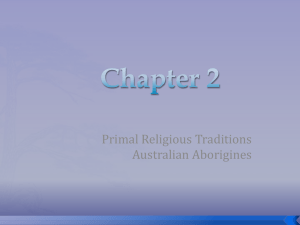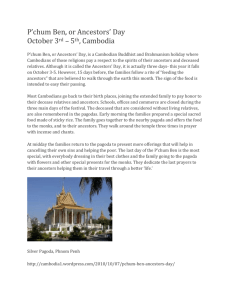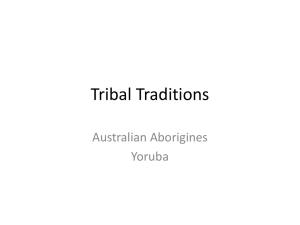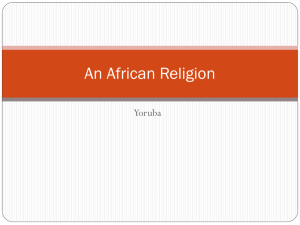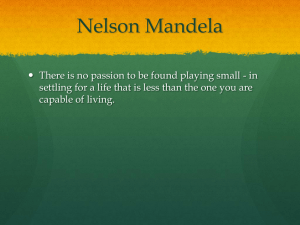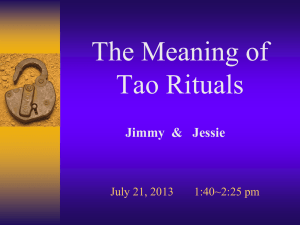wr with hypernnn - St. Jean Baptiste High School
advertisement
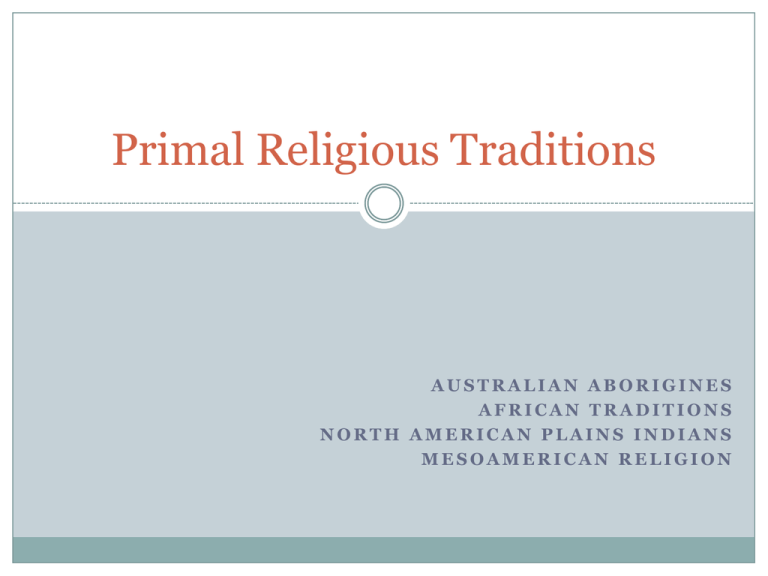
Primal Religious Traditions AUSTRALIAN ABORIGINES AFRICAN TRADITIONS NORTH AMERICAN PLAINS INDIANS MESOAMERICAN RELIGION Primal Religions Unique forms of religions practiced since prehistoric times. Some are still practiced at present. Religious traditions of non literate peoples who rely on oral tradition rather than scriptures Tend to be the traditions of tribal peoples, small groups that reside in villages rather than large city populations Why investigate Primal Religious Traditions? Primal: Prehistoric, Non-literate, oral tradition Provide insight into mythic and ritual dimensions of religion that are essential sources of knowledge and power for important aspects of life All religions stem from or are rooted in primal worship Australian Aborigines Native people of Australia Foundation Dreaming Period of the ANCESTORS Still remains in the symbols left behind Rituals reenact the mythic events Ancestors Supernatural beings that gave shape to the formless world Organized humans into tribes Allocated land Left symbols of their presence Spirit of ancestors left behind Ritual Spiritual essences left behind by the ancestors in symbols Charged with sacred power Take the same paths originally taken by the ancestors reenacting the mythic events of the dreaming Cosmology takes a key place in Aboriginal religionmythic geography Spiritual essence in humans also. Unborn child is animated by an Ancestor when the mother makes contact with a sacred site. Totem: the natural form of the ancestor in the dreaming Totemism: a system of belief and ritual based on totems Animation Ancestors continually nourish the natural world, sources of all kinds of life Human beings associated with a particular ancestor perform rituals to cause the power to flow into the natural world Reenactment of the myth Reenacting of the myth recreates the original action Maintaining the social structure of society Taboo: things and activities set aside for certain members and forbidden to others Gender Training Maturity Initiation Awakens spiritual identity Death of childhood- birth of adulthood African Traditions Several hundred religions among the 400,000,000 inhabitants of the second largest continent, Africa. Yoruba Religion Consists of 10,000,000 people and has endured 1,000 years. Produced artwork that is famous and admired Resides in Western regions of central Africa Favor city living Ife is the center of Yoruba religion Orishna-nla began world creation here http://www.genuineafrica.com/yoru ba.htm#.TynstWd8Mxc.email Cosmology Reality is in two separate worlds Heaven, the invisible home of the gods and ancestors Earth, the world of normal experience, visible home of humans; also populated by a deviant form of human beings, witches and sorcerers, who can cause disastrous harm if not controlled Purpose of the religion Maintain balance between the human beings of earth and the gods and ancestors of heaven while guarding against the evil deeds of the sorcerers and witches Heaven Home of Supreme god- Olorun Primary, original source of power in the universe Distant and remote- not involved in human affairs People do not worship Olorun; other gods serve as mediators Other deities- orishas Lesser than Olorun but truly significant Are appeased by the rituals carried out by humans Hundreds of orishas exist Orisha-nla, created earth Ogun, god of iron, originally a human, inhabits border between ancestors and orishas Esu, most complex, contains both good and evil properties, worshipped with all other gods- Trickster figure (can disrupt the normal course of life) Cont’d Ancestors: Deceased humans who have acquired supernatural powers They can help or harm the living Worshipped through rituals at sacred shrines Earned a good reputation, lived to an old age, worshipped only by their own family Deified ancestors known throughout Yoruba society and worshipped by large numbers of people Connecting Heaven and Earth Head of a family: Worships the family’s ancestors in the home at the family shrine King or chief of a city: In charge of annual festivals and performs other religious functions Priests Oversee the various rituals carried out at the shrines of each orisha Diviners Tells the future since this is important in determining how to proceed with ones life Mediator Becomes a living representation of an ancestor by dancing at festivals Imitates a dead person and delivers a message from the dead Importance: Maintains a balance between heaven and earth, boundaries are thin and can be crossed over North American Plains Indians Peoples who inhabited the middle section of what is now the USA. Migrated from Asia over the Bering Strait and spread out over north and south America Stretched from Canadian Alberta to the Gulf of Mexico, between Rocky Mountains and the Mississippi River. More than 30 tribes, speaking different languages and forming many cultural groups Representative of Native American religion in general Shared some basic beliefs such as the vision quest and the Sun Dance. Lakota Inhabited Eastern Montana & Wyoming and the western part of the Dakotas and parts of Nebraska Reknown for Custer’s defeat Massacre at Wounded knee About 70,000 live on reservations in Manitoba, Montana, and the Dakotas. Beliefs Supreme Reality- Wakan Tanka, the Great Spirit or Great Mysterious 16 different deities (4x4) Creation of the world and the arrival of the first human beings are explained in various myths that talk about several supernatural beings Inktomi, Lakota trickster figure, taught humans their ways and customs. His mistakes and errors of judgment are used to teach children what not to do. Death & Afterlife 4 souls depart from body, one journeys on a spirit path encounters an old woman who judges it and directs it to the world of the ancestors or back to earth as a ghost. Others are reborn in unborn children or others new bodies. Ritual Vision Quest Common primal tradition To gain access to spiritual power that will insure success in different undertakings Both genders can participate Supervised by a medicine man or woman Begins with purification in a sweat lodge Goes off alone to endure the elements, lack of food and water Performance of certain rituals Near the end the quester receives a vision in the form of an animal, object or force of nature. Vision gives a message. Message is interpreted by medicine man or woman, that interpretation influences the rest of the life of the quester. Occasionally the quester receives a guardian spirit Ritual Sun Dance: Common to all Plains’ tribes Benefits the tribe rather than the individual Part of the New Year celebration Overseen by a sacred leader (medicine man or a woman of outstanding character), both an honor and a responsibility Held in a lodge that is carefully constructed and prepared for the celebration Cotton tree is set upright in a chosen spot as the axis mundi Connects heaven and earth- represents the supreme being Around the tree, 28 poles to represent the 28days of the lunar month Dancing in the direction of the sun accompanied by music and drumbeats Body mutilation as sacrifice Populating the Americas Crossing at Beringia Mesoamerican Religion Area includes present day Mexico and extended south to Honduras, Nicaragua, and Costa Rica Natives arrived about 20,000 years ago? From about 2000 BC to 1500 AD home to Olmecs, Maya, Toltec and Aztec civilizations Aztecs Defies the common or general description of primal religions- it was a highly civilized population of about 15,000,000. Urban dwellers in lieu of rural. Lived in Tenochtitlahn, now Mexico City Like other primal religions it intertwines ritual and myth, practices of human sacrifice Pre dated Catholicism of 16th c. Aztec influence can be seen in some modern Mexican religious practices Toltec Foundation Toltec god “Quetzalcoatl” the feathered serpent presided over a golden age of brilliance Prince Topiltzin, a priest-king of the Toltecs, was the role model for Aztec authority figures Toltec myths and tradition influenced Aztecs Aztecs believed that Quetzalcoatl created and ordered the world. City of Teotihuancan was origin of the cosmos. “Who will be the sun and bring on the dawn?” Time and Space The dawn of the sun was a new age and its destruction the end of that age. The only ;way to delay this destruction was to feed the sun, nourishing it through human sacrifices. They believed that there had already been 4 suns and theirs was the last one. (center, west, north, south) Time and space were interrelated. 4 quadrants with the axis mundi in center. Center connects earthly world with heavenly world. Human Role Human condition linked to cosmology Human is a sort of axis mundi Human sacrifice was performed about every 20 days. Self sacrifice of the warrior would allow him to enter the highest heaven at his death Two divine forces Heart Was cut out of the chest on a sacrificial altar Head Was severed from the body and strung on a skull rack Many human sacrifices were captive prisoners Language Religious power was conveyed through the mastery of language Spoke Nahuatl, an expressive language with high achievements in poetry Knowers of things could communicate with the gods and make offerings rather than sacrifice. Being adept at making or solving riddles meant you came from a good family

